|
|
|
Sort Order |
|
|
|
Items / Page
|
|
|
|
|
|
|
| Srl | Item |
| 1 |
ID:
091891
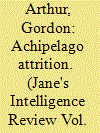

|
|
|
|
|
| Publication |
2009.
|
| Summary/Abstract |
The Islamist insurgent group, the Abu Sayyaf Group, has proven its ability to inflict significant losses on the Philippine military in recent attacks. Gorden Arthur examines the army's operations aimed at dismantling the rebel group and undermining its civilian support.
|
|
|
|
|
|
|
|
|
|
|
|
|
|
|
|
| 2 |
ID:
096559
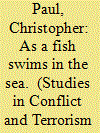

|
|
|
|
|
| Publication |
2010.
|
| Summary/Abstract |
This article reviews and synthesizes social science knowledge on the connections between popular support and terrorist/insurgent sustainment. After distinguishing between "sympathetic of" and "supporting," the author identifies support requirements of terrorists and insurgents, the range of sources of support, and motives for support. A scheme of relationships between factors contributing to strength of support is essayed. As a caveat to population-centered approaches to counterterrorism and counterinsurgency, the article concludes that support is not "one size fits all," and that certain factors, when present, are more amenable to policy influence than others. These conclusions suggest that it is imperative that practitioners of counterterrorism and counterinsurgency be mindful of the specifics of their case when seeking to undermine support.
|
|
|
|
|
|
|
|
|
|
|
|
|
|
|
|
| 3 |
ID:
089768
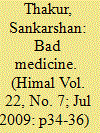

|
|
|
|
|
| Publication |
2009.
|
| Summary/Abstract |
Naxalism is, undeniably, a law-and -order problem, but it is not that alone; the violence Naxalites often wreak is a virulent symptom, not the disease itself. And untill the government realises that, its remedies are doomed to failure. The state government's 22 June ban on the Naxalites following the outbreak in Bengal is a mere updating-the-books exercise, nothing more. Maoist groups had long been banned; it is only that the government had not taken cognisance of their merger into one group.
|
|
|
|
|
|
|
|
|
|
|
|
|
|
|
|
| 4 |
ID:
122621
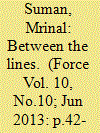

|
|
|
| 5 |
ID:
190835
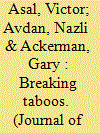

|
|
|
|
|
| Summary/Abstract |
Much ado has been made about the specter of unconventional weapons in the hands of militant groups. Despite the alarmism of the policy community, the pursuit of chemical, biological, radiological, and nuclear capabilities by non-state actors is rare. What explains why some violent non-state organizations pursue chemical, biological, radiological, and nuclear weapons while most do not? Using new data on organizational behaviors and attributes from the Big Allied and Dangerous 2 Insurgency project, we analyze 140 insurgent actors, from 1998 to 2012. We expand previous work by Asal, Ackerman & Rethemeyer by studying the phenomenon longitudinally and attending to organizational behavior rather than only to structural and environmental factors. We find that organizations that attack cultural sites are more likely to pursue and use chemical, biological, radiological, and nuclear weapons. We interpret the latter as a willingness to transgress upon accepted mores, for the sake of sensationalism and shock value, which coheres with a willingness to pursue unconventional weapons. Our results reflect that chemical, biological, radiological, and nuclear pursuit and use is part of a larger strategy for some violent non-state organizations, one predicated on generating mass fear and exacting a psychological toll.
|
|
|
|
|
|
|
|
|
|
|
|
|
|
|
|
| 6 |
ID:
132229
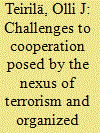

|
|
|
|
|
| Publication |
2014.
|
| Summary/Abstract |
The recent conflict in the Sahel area is another case where the nexus of terrorism and organized crime causes challenges to the international community. Comparing the situation with that of the Andean region brings forth the challenges faced when dealing with this type of conflict: the states' weak presence in the remote regions, the insurgents' ability to offer income and "security" to the people, immediate threat to international investments, unresolved political/regional issues, the marriage of convenience of insurgents/terrorists and organized crime, internal divisions of the insurgent groups and also ideologies surviving or suffering after the elimination of their leaders
|
|
|
|
|
|
|
|
|
|
|
|
|
|
|
|
| 7 |
ID:
129883
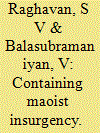

|
|
|
| 8 |
ID:
107533
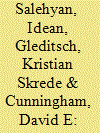

|
|
|
|
|
| Publication |
2011.
|
| Summary/Abstract |
Many rebel organizations receive significant assistance from external governments, yet the reasons why some rebels attract foreign support while others do not is poorly understood. We analyze factors determining external support for insurgent groups from a principal-agent perspective. We focus on both the supply side, that is, when states are willing to support insurgent groups in other states, and the demand side, that is, when groups are willing to accept such support, with the conditions that this may entail. We test our hypotheses using new disaggregated data on insurgent groups and foreign support. Our results indicate that external rebel support is influenced by characteristics of the rebel group as well as linkages between rebel groups and actors in other countries. More specifically, we find that external support is more likely for moderately strong groups where support is more likely to be offered and accepted, in the presence of transnational constituencies, international rivalries, and when the government receives foreign support.
|
|
|
|
|
|
|
|
|
|
|
|
|
|
|
|
| 9 |
ID:
133613
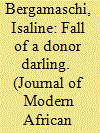

|
|
|
|
|
| Publication |
2014.
|
| Summary/Abstract |
This article offers a political economy perspective on the Malian crisis with a focus on aid and donor practices. The argument is two-fold. On the one hand, aid consolidated a regime that grew increasingly discredited, so that aid and donors - voluntarily or otherwise - contributed to create the pre-2012 context of fragility. On the other hand, this structural gap has created a state of affairs that provided some impulse and support to putschists and insurgent groups. It explores four channels through which this has happened in practice. External funding agencies have sponsored what was perceived as President Amadou Toumani Touré's 'mismanagement' of the situation in the north and the degradation of governance. In addition, donors exerted weak control over policies and ignored signals of growing popular dissatisfaction with ATT. Finally, when they tried to put pressure on governments, donors chose highly controversial issues and have enacted unpopular conditionalities, which have had destabilising effects.
|
|
|
|
|
|
|
|
|
|
|
|
|
|
|
|
| 10 |
ID:
091895
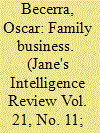

|
|
|
|
|
| Publication |
2009.
|
| Summary/Abstract |
Born form the remains of the Gulf Cartel and Zetas, La Familia has grown into Mexico's most violent criminal organisation. Here author charts the group's development and expansion and the consequences this could have for regional security within the region.
|
|
|
|
|
|
|
|
|
|
|
|
|
|
|
|
| 11 |
ID:
125234
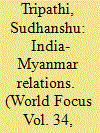

|
|
|
|
|
| Publication |
2013.
|
| Summary/Abstract |
India's Myanmar policy and its shift from an idealist position to one that is driven by pragmatism is a subject matter of much importance today as regards the success of India's rejuvenated 'Look East Policy'. Considering the reasons for the policy change, the article examines as to how far the policy is adequate for fulfilment of India's objectives in that country. But, above all, India has to maintain a cordial relationship with Myanmar's newly elected civilian government headed by President Thein Sein to extend its influence in Southeast Asia and also due to internal security concerns of its north-eastern states, which are under continuous threat from various insurgent groups.
|
|
|
|
|
|
|
|
|
|
|
|
|
|
|
|
| 12 |
ID:
160363
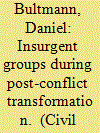

|
|
|
|
|
| Summary/Abstract |
The article discusses the experiences of a group of military strongmen during the post-conflict transformation of two Cambodian insurgent movements into a society of peace after a decades-long civil war. It explains the reasons why some of these strongmen were able to transfer their high status within the insurgency into senior positions in the incumbent government, while others became impoverished and sometimes even preferred to relapse into further conflict. Even though all of these strongmen shared a very similar life course and fought until the end of the conflict, their post-conflict fates have been very different. Central to the explanation of their behaviour during the transition is their habitus, the set of resources at their disposal and the nature of their vertical and horizontal social networks.
|
|
|
|
|
|
|
|
|
|
|
|
|
|
|
|
| 13 |
ID:
146758
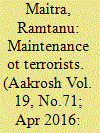

|
|
|
| 14 |
ID:
130647
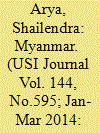

|
|
|
| 15 |
ID:
131067


|
|
|
| 16 |
ID:
129597
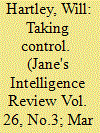

|
|
|
| 17 |
ID:
140789
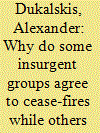

|
|
|
|
|
| Summary/Abstract |
This article uses Burma/Myanmar from 1948 to 2011 as a within-case context to explore why some armed insurgent groups agree to cease-fires while others do not. Analyzing 33 armed groups it finds that longer-lived groups were less likely to agree to cease-fires with the military government between 1989 and 2011. The article uses this within-case variation to understand what characteristics would make an insurgent group more or less likely to agree to a cease-fire. The article identifies four armed groups for more in-depth qualitative analysis to understand the roles of the administration of territory, ideology, and legacies of distrust with the state as drivers of the decision to agree to or reject a cease-fire.
|
|
|
|
|
|
|
|
|
|
|
|
|
|
|
|
| 18 |
ID:
172496
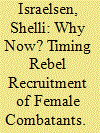

|
|
|
|
|
| Summary/Abstract |
Using case study evidence, this article demonstrates how the relationship between conflict intensity, gender inclusive ideologies and gender inclusive policies on one hand, and the decision to recruit female combatants on the other hand, is conditioned by the groups' conflict phase. Conflict phases divide conflict events into two distinct parts, the guerrilla activity phase and the civil war phase, contingent on the insurgents' number of armed fighters, military capabilities, level of institutionalization and degree of territorial control. These conflict phases affect the recruitment behavior of insurgent groups making them more likely to recruit female combatants in the civil war phase and less likely to do so in the guerrilla activity phase.
|
|
|
|
|
|
|
|
|
|
|
|
|
|
|
|
|
|
|
|
|